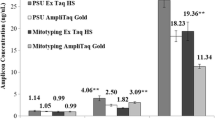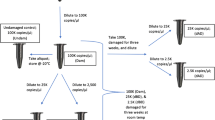Abstract
Hair shafts are one of the most common types of evidence at crime scenes, and mitochondrial DNA (mtDNA) has been analyzed as a valuable genetic marker for hair shafts in forensic casework. However, the mtDNA analysis strategy may vary according to the quantity and quality of DNA extracted from a forensic sample and the available massively parallel sequencing (MPS) platform in laboratories. Forensic practitioners often have to interpret mtDNA sequences exhibiting point heteroplasmy (PHP) that are analyzed using different analytical methods. In the present study, the whole mitochondrial genome (mtGenome) variants of hair shaft samples obtained from 20 donors, which were sampled in duplicate and stored at room temperature for > 1 year, were analyzed using the Precision ID mtDNA Whole Genome Panel and Ion S5 system. The whole mtGenome variants of 20 blood and 20 buccal swab samples (reference samples) from the hair shaft donors were analyzed using the Nextera XT DNA Library Prep Kit and MiSeq System. A total of 20 unique mtGenome haplotypes were observed, and 56 PHP variants were identified across the 4 sets of tissue. When the major nucleotide of PHP was considered, 16 of 20 haplotypes of the hair shaft samples matched those of the corresponding blood and buccal swab samples. In four donors, the major nucleotide of PHP was inverted at one nucleotide position between the hair shaft and reference samples. However, the data obtained on MPS, showing high PHP resolution, provided substantial information to avoid false exclusion when comparing two haplotypes containing PHP with inverted major nucleotides. In conclusion, the present study demonstrates the utility of MPS in forensic casework in the comparative analysis of mtGenome variants containing PHP.

Similar content being viewed by others
References
Robin ED, Wong R (1988) Mitochondrial DNA molecules and virtual number of mitochondria per cell in mammalian cells. J Cell Physiol 136:507–513
Budowle B, Allard MW, Wilson MR, Chakraborty R (2003) Forensics and mitochondrial DNA: applications, debates, and foundations. Annu Rev Genomics Hum Genet 4:119–141
Allen M, Engstrom AS, Meyers S et al (1998) Mitochondrial DNA sequencing of shed hairs and saliva on robbery caps: sensitivity and matching probabilities. J Forensic Sci 43:453–464
Melton T, Dimick G, Higgins B, Lindstrom L, Nelson K (2005) Forensic mitochondrial DNA analysis of 691 casework hairs. J Forensic Sci 50:73–80
Irwin JA, Saunier JL, Strouss KM et al (2007) Development and expansion of high-quality control region databases to improve forensic mtDNA evidence interpretation. Forensic Sci Int Genet 1:154–157
Chaitanya L, Van Oven M, Brauer S et al (2016) High-quality mtDNA control region sequences from 680 individuals sampled across the Netherlands to establish a national forensic mtDNA reference database. Forensic Sci Int Genet 21:158–167
Just RS, Scheible MK, Fast SA, Sturk-Andreaggi K, Röck AW, Bush JM, Higginbotham JL, Peck MA, Ring JD, Huber GE, Xavier C, Strobl C, Lyons EA, Diegoli TM, Bodner M, Fendt L, Kralj P, Nagl S, Niederwieser D, Zimmermann B, Parson W, Irwin JA (2015) Full mtGenome reference data: Development and characterization of 588 forensic-quality haplotypes representing three U.S. populations. Forensic Sci Int Genet 14:141–155
McElhoe JA, Holland MM, Makova KD, Su MS, Paul IM, Baker CH, Faith SA, Young B (2014) Development and assessment of an optimized next-generation DNA sequencing approach for the mtgenome using the Illumina MiSeq. Forensic Sci Int Genet 13:20–29
King JL, LaRue BL, Novroski NM, Stoljarova M, Seo SB, Zeng X, Warshauer DH, Davis CP, Parson W, Sajantila A, Budowle B (2014) High-quality and high-throughput massively parallel sequencing of the human mitochondrial genome using the Illumina MiSeq. Forensic Sci Int Genet 12:128–135
Gabriel MN, Huffine EF, Ryan JH, Holland MM, Parsons TJ (2001) Improved MtDNA sequence analysis of forensic remains using a “mini-primer set” amplification strategy. J Forensic Sci 46:247–253
Eichmann C, Parson W (2008) “Mitominis”: multiplex PCR analysis of reduced size amplicons for compound sequence analysis of the entire mtDNA control region in highly degraded samples. Int J Legal Med 122:385–388
Peck MA, Brandhagen MD, Marshall C, Diegoli TM, Irwin JA, Sturk-Andreaggi K (2016) Concordance and reproducibility of a next generation mtGenome sequencing method for high-quality samples using the Illumina MiSeq. Forensic Sci Int Genet 24:103–111
Calloway CD, Reynolds RL, Herrin GL, Anderson WW (2000) The frequency of heteroplasmy in the HVII region of mtDNA differs across tissue types and increases with age. Am J Hum Genet 66:1384–1397
Naue J, Hörer S, Sänger T, Strobl C, Hatzer-Grubwieser P, Parson W, Lutz-Bonengel S (2015) Evidence for frequent and tissue-specific sequence heteroplasmy in human mitochondrial DNA. Mitochondrion 20:82–94
Just RS, Irwin JA, Parson W (2015) Mitochondrial DNA heteroplasmy in the emerging field of massively parallel sequencing. Forensic Sci Int Genet 18:131–139
Fendt L, Zimmermann B, Daniaux M, Parson W (2009) Sequencing strategy for the whole mitochondrial genome resulting in high quality sequences. BMC Genomics 10:139
Andrews RM, Kubacka I, Chinnery PF et al (1999) Reanalysis and revision of the Cambridge reference sequence for human mitochondrial DNA. Nat Genet 23:147
Li H, Durbin R (2009) Fast and accurate long-read alignment with Burrows-Wheeler transform. Bioinformatics 25:1754–1760
Martin M (2011) Cutadapt removes adapter sequences from high-throughput sequencing reads. EMBnet J 17:10–12
Van der Auwera GA, Carneiro MO, Hartl C et al (2014) From FastQ data to high confidence variant calls: the Genome Analysis Toolkit best practices pipeline. Curr Protoc Bioinformatics 11:1–42
Thermo Fisher Scientific (2016) Precision ID mtDNA panels with the HID Ion S5TM/HID Ion GeneStudioTM S5 System
Parson W, Gusmão L, Hares DR, Irwin JA, Mayr WR, Morling N, Pokorak E, Prinz M, Salas A, Schneider PM, Parsons TJ, DNA Commission of the International Society for Forensic Genetics (2014) DNA Commission of the International Society for Forensic Genetics: revised and extended guidelines for mitochondrial DNA typing. Forensic Sci Int Genet 13:134–142
Thorvaldsdóttir H, Robinson JT, Mesirov JP (2012) Integrative Genomics Viewer (IGV): high-performance genomics data visualization and exploration. Brief Bioinform 14:178–192
Parson W, Dür A (2007) EMPOP-a forensic mtDNA database. Forensic Sci Int Genet 1:88–92
Lee HY, Yoo JE, Park MJ, Chung U, Kim CY, Shin KJ (2006) East Asian mtDNA haplogroup determination in Koreans: haplogroup-level control region SNP analysis and subhaplogroup-level control region sequence analysis. Electrophoresis 27:4408–4418
Parson W, Huber G, Moreno L, Madel MB, Brandhagen MD, Nagl S, Xavier C, Eduardoff M, Callaghan TC, Irwin JA (2015) Massively parallel sequencing of complete mitochondrial genomes from hair shaft samples. Forensic Sci Int Genet 15:8–15
Strobl C, Eduardoff M, Bus MM, Allen M, Parson W (2018) Evaluation of the precision ID whole MtDNA genome panel for forensic analyses. Forensic Sci Int Genet 35:21–25
Gallimore JM, McElhoe JA, Holland MM (2018) Assessing heteroplasmic variant drift in the mtDNA control region of human hairs using an MPS approach. Forensic Sci Int Genet 32:7–17
Linch CA, Whiting DA, Holland MM (2001) Human hair histogenesis for the mitochondrial DNA forensic scientist. J Forensic Sci 46:844–853
Desmyter S, Bodner M, Huber G, Dognaux S, Berger C, Noël F, Parson W (2016) Hairy matters: MtDNA quantity and sequence variation along and among human head hairs. Forensic Sci Int Genet 25:1–9
Irwin JA, Saunier JL, Niederstätter H, Strouss KM, Sturk KA, Diegoli TM, Brandstätter A, Parson W, Parsons TJ (2009) Investigation of heteroplasmy in the human mitochondrial DNA control region: a synthesis of observations from more than 5000 global population samples. J Mol Evol 68:516–527
Li M, Schröder R, Ni S et al (2015) Extensive tissue-related and allele-related mtDNA heteroplasmy suggests positive selection for somatic mutations. Proc Natl Acad Sci 112:2491–2496
Acknowledgments
The authors would like to thank P.H. Kim and C.H. Lee from Thermo Fisher Scientific Korea for their generous support for this research.
Funding
This study was supported by the Bio & Medical Technology Development Program of the National Research Foundation (NRF) funded by the Ministry of Science and ICT (NRF-2014M3A9E1069989).
Author information
Authors and Affiliations
Corresponding author
Ethics declarations
Conflict of interest
The authors declare that they have no conflicts of interest.
Ethical approval
All procedures performed in studies involving human participants were in accordance with the ethical standards of the Institutional Review Board of Severance Hospital, Yonsei University, Seoul, Korea (4-2015-1068) and with the 1964 Helsinki declaration and its later amendments or comparable ethical standards.
Informed consent
Informed consent was obtained from all individual participants included in the study.
Additional information
Publisher’s note
Springer Nature remains neutral with regard to jurisdictional claims in published maps and institutional affiliations.
Rights and permissions
About this article
Cite this article
Kim, B.M., Hong, S.R., Chun, H. et al. Comparison of whole mitochondrial genome variants between hair shafts and reference samples using massively parallel sequencing. Int J Legal Med 134, 853–861 (2020). https://doi.org/10.1007/s00414-019-02205-y
Received:
Accepted:
Published:
Issue Date:
DOI: https://doi.org/10.1007/s00414-019-02205-y




